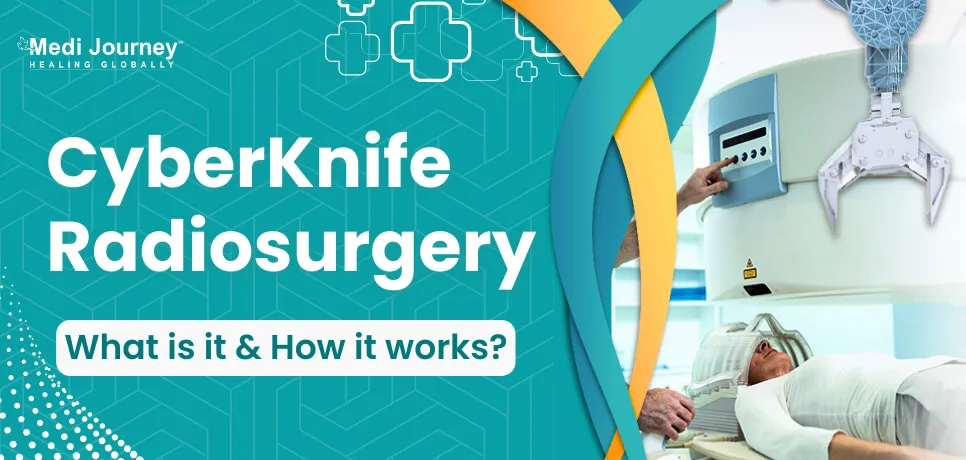Best Orthopedic Surgeons in Artemis Hospital Gurgaon
 17 December,2025
Read More
17 December,2025
Read More
Enquire now in case of any assistance needed

Cancer has become one of the most fatal diseases in today's time. The disease is responsible for claiming millions of lives each year. However, with advancements in medical technology, the treatment modalities for cancer have also increased. While surgery, radiation, and chemo remain the primary treatments for cancer, there are various additions to how these treatments are given.
The CyberKnife® System is revolutionizing cancer treatment in multiple nations, including India. It's a type of radiation therapy that can reach body areas previously thought unreachable. It is ideally suited for patients who cannot undergo surgery.
Are you excited to learn more? Read this blog, and you will get all the necessary information about CyberKnife and how it helps cancer patients beat the disease.
Fill up the form and get assured assitance within 24 hrs!
CyberKnife is a noninvasive way of killing benign and malignant tumors. It uses SRBT—stereotactic body radiation therapy—to deliver precise doses of radiation anywhere in the body.
Precise targeting of radiations is possible due to the image-guided linear accelerator on the robotic arm and motion synchronization technology. In simple words, the CyberKnife System can detect the movement of tumors in real time and adjust the beams accordingly.
CyberKnife is a non-surgical solution that destroys tumors by aiming radiation beams at them from multiple directions while sparing healthy tissues. The treatment process of CyberKnife can be divided into three steps – Planning, Setup, and Delivery.

CyberKnife radiosurgery is commonly used to treat complex and inoperable tumors. It is an excellent substitute for patients who cannot or do not want to undergo surgery. Oncologists also recommend it for patients with tumors in sensitive or hard-to-reach places.
Common diseases that doctors treat using the CyberKnife System are –
CyberKnife System offers several advantages over traditional radiation techniques. It is impossible to hold your breath while receiving any treatment. CyberKnife has an added advantage because its precision is not affected by regular body movements such as breathing or coughing while receiving the therapy. Other benefits are –
CyberKnife treatment has brought a ray of hope among many individuals battling cancer. It is a painless procedure that can manage various kinds of tumors throughout the body. The cost of CyberKnife treatment in the US and UK averages around USD 15,000 to USD 30,000.
The high prices can be burdensome for some people. However, you don’t need to be disheartened. Various countries—India, Germany, Turkey, and others—offer CyberKnife Systems at affordable prices.
The cost of CyberKnife radiosurgery in India ranges from USD 4,000 to USD 7,000. The cost of treatment varies according to the type of cancer and the number of sessions required. Contact an expert radiation oncologist who can guide you through the process and the costs.
CyberKnife has transformed cancer treatment. This noninvasive alternative to surgery offers benefits over standard procedures, like greater accuracy, shorter treatment times, and fewer side effects. CyberKnife combines cutting-edge robotic technology with the expertise of highly trained medical professionals, resulting in high patient satisfaction. If you or someone you care about is fighting cancer or a tumor, consider CyberKnife as an option. It provides a new approach to cancer treatment that is more effective and does not require any cuts.
Fill up the form and get assured assitance within 24 hrs!
Doctor of Pharmacy
Dr. Deepanshu Siwach is a skilled clinical pharmacist with a Doctor of Pharmacy degree.?He has 4+?years of experience and has worked with thousands of patients. He has been associated with some of the top hospitals, such as Artemis Gurgaon.
Dr. Vivek Gupta is an experienced Surgical Oncologist with over 16 years of practice....
Senior Consultant
Medical Oncologist
Nanavati Super Specialty Hospital, Mumbai
WhatsApp UsSenior Director
Gynecologist and Obstetrician, IVF Specialist
Max Super Speciality Hospital, Shalimar Bagh, New Delhi
WhatsApp UsSenior Director
Gynecologist and Obstetrician, IVF Specialist
Max Smart Super Speciality Hospital, Saket, New Delhi
WhatsApp UsSenior Director
Gynecologist and Obstetrician
Max Smart Super Speciality Hospital, Saket, New Delhi
WhatsApp UsSenior Director
Gynecologist and Obstetrician
Max Smart Super Speciality Hospital, Saket, New Delhi
WhatsApp UsSenior Director
Gynecologist and Obstetrician
Max Smart Super Speciality Hospital, Saket, New Delhi
WhatsApp UsThe Art of Effective Communication
 17 December,2025
Read More
17 December,2025
Read More
 16 December,2025
Read More
16 December,2025
Read More
 10 December,2025
Read More
10 December,2025
Read More
 09 December,2025
Read More
09 December,2025
Read More
 05 December,2025
Read More
05 December,2025
Read More
 04 December,2025
Read More
04 December,2025
Read More
Trusted by Patients
"I am Asim from Bangladesh and was looking for treatment in India for neuro. I visited many websites to get the complete information regarding the treatment but I was not satisfied as I was getting confused. In the meanwhile, one of my friends suggested I seek help from Medi Journey as he experienced his medical journey very smoothly and was satisfied with it. They have filtered the top 10 doctors as per experience, the success rate of surgery & profile, so it helps us to choose the best treatment in India. "
"For my knee surgery, Medi Journey guided me to BLK Hospital where I received exceptional care. The team's support and the expertise at BLK Hospital exceeded my expectations. Thank you Medi Journey for making my medical journey stress-free. "
"I came from Iraq for my granddaughter's eye surgery in India facilitated by Medi Journey, due to critical cases they advised us to get a second opinion from the different hospitals before going to surgery. Finally, we went to Fortis Escort Hospital, which helped us to get more confidence for diagnosis. Fortis Escort Hospital has the best eye surgeon team with the latest instruments. Thanks to all team members for providing a high-quality treatment in India at an affordable cost. "
"I came for my hair transplant in India, before coming I was so confused about choosing the best clinic and surgeon for me. But thanks to God one of my friends had a hair transplant in India through Medi Journey. He recommended me to go with them. I am completely happy with my experience with them. They were always very fast in their responses to me. the success rate of my hair transplant surgery is 100%."
"Artemis Hospital, suggested by Medi Journey, turned out to be a great choice for my treatment. The personalized assistance and medical care were exceptional. I'm grateful to Medi Journey for guiding me to a hospital that perfectly matched my needs. Highly recommended! "
"I came from Afghanistan for my treatment in India at Jaypee Hospital, Noida. I had a fantastic experience with Medi Journey. Kudos to them for their incredible support during my medical journey. They not only took care of all the logistics but also connected me with a fantastic healthcare team. Efficient, caring, and highly recommended for a hassle-free medical tourism experience."
"I am Adam from Kano, Nigeria, one of my friends from Nigeria was facilitated by Medi Journey, and he recommended us to go with them. I sent my all reports to them and within 48 hours they reverted with 4 options from different hospitals. They helped me to get a Visa letter from the hospital, arrange pick-up from the airport, and book a hotel for me. Their team is very honest and throughout our stay in India they are with us they are caring for us like his family members. BLK Hospital is the best hospital in India with a top surgical oncologist surgeon team, a very advanced OT, and a Radiotherapy department. I wish more success to Medi Journey. "
"Great experience at the Max Hospital for my spine surgery and was successfully done. I thank my neurosurgeon and his entire team. I recommended all of my country's people to Medi Journey for treatment in India, they choose the best hospital, the best doctors, and the best cost for patients."
"I came to India from Dhaka, Bangladesh for my father-in-law's cardiac surgery at Fortis Hospital. I was confused about choosing the best surgeon for him before coming, but their team helped me to choose the best hospital and best cardiac surgeon in India with very good cost and 100% success rate of surgery. I am very happy with the services, really they make my journey so comfortable that make me feel at home. Thanks again and I like people to choose "Medi Journey" as your travel guide. "
"I am Mohammad from Bangladesh came to India for my general health checkup. Medi Journey offers me the complete package including Pick-up from the airport, hotel services, and 24-hour assistance. They guide you to choose the best hospital in India, the best cost of treatment with top-most doctors and give you complete information about hotel booking, and pick-up from the airport before coming to India They have the best team to help. Always choose Medi Journey for your treatment in India."





